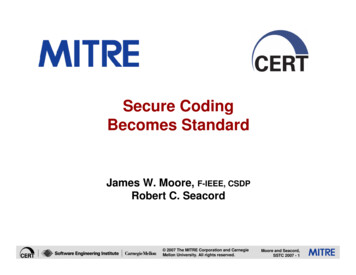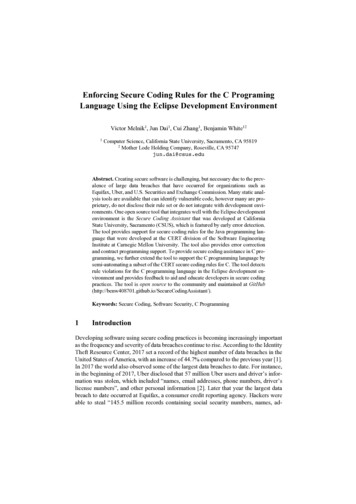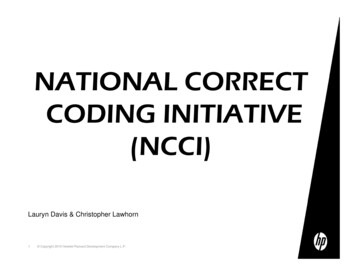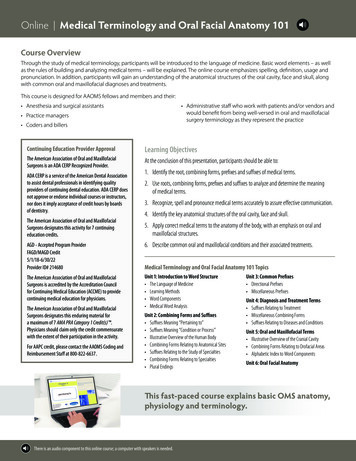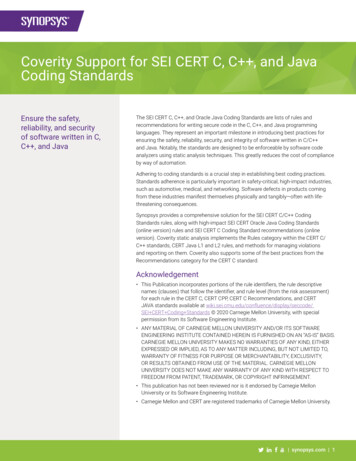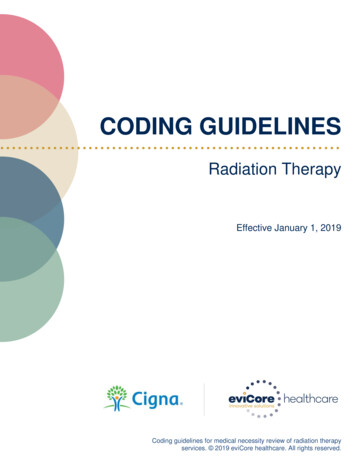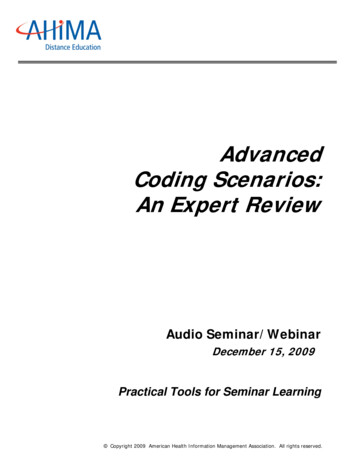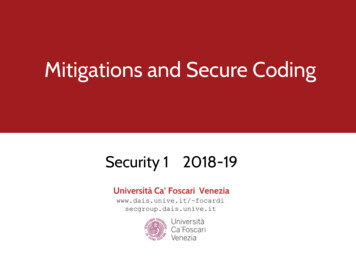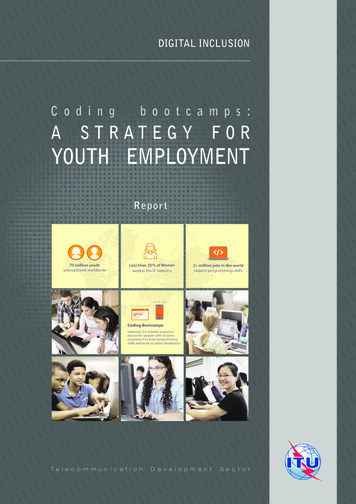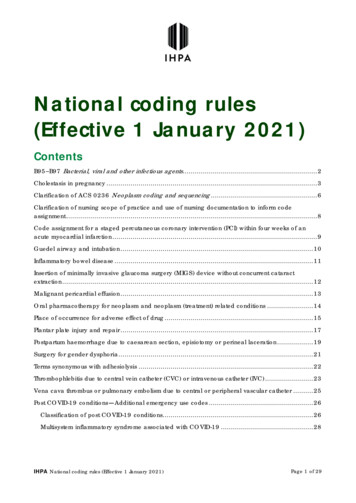
Transcription
National coding rules(Effective 1 January 2021)ContentsB95 B97 Bacterial, viral and other infectious agents. 2Cholestasis in pregnancy . 3Clarification of ACS 0236 Neoplasm coding and sequencing . 6Clarification of nursing scope of practice and use of nursing documentation to inform codeassignment . 8Code assignment for a staged percutaneous coronary intervention (PCI) within four weeks of anacute myocardial infarction . 9Guedel airway and intubation . 10Inflammatory bowel disease .11Insertion of minimally invasive glaucoma surgery (MIGS) device without concurrent cataractextraction . 12Malignant pericardial effusion . 13Oral pharmacotherapy for neoplasm and neoplasm (treatment) related conditions . 14Place of occurrence for adverse effect of drug .15Plantar plate injury and repair . 17Postpartum haemorrhage due to caesarean section, episiotomy or perineal laceration . 19Surgery for gender dysphoria .21Terms synonymous with adhesiolysis . 22Thrombophlebitis due to central vein catheter (CVC) or intravenous catheter (IVC) . 23Vena cava thrombus or pulmonary embolism due to central or peripheral vascular catheter .25Post COVID-19 conditionsAdditional emergency use codes . 26Classification of post COVID-19 conditions.26Multisystem inflammatory syndrome associated with COVID-19 .28IHPA National coding rules (Effective 1 January 2021)Page 1 of 29
Ref No: Q3522 Published On: Dec-2020 Status: CurrentB95 B97 Bacterial, viral and other infectiousagentsQ:Can a code from block B95 B97 be assigned with another code from Chapter 1 to add specificity?A:Codes in block B95 B97 Bacterial, viral and other infectious agents are assigned to identify certainorganisms as the cause of diseases classified to other chapters. Therefore, they are never assignedwith another code from Chapter 1 Certain infectious and parasitic diseases to classify a singleclinical concept (ie a single infection).For example: Sepsis due to Klebsiella pneumoniae is a single clinical concept. Assign A41.58 Sepsis dueto other Gram-negative organisms.Follow the ICD-10-AM Alphabetic Index:Sepsis (generalised)- Gram-negative (organism)- - specified NEC A41.58 Bacteraemia due to Klebsiella pneumoniae is a single clinical concept. Assign A49.8 Otherbacterial infections of unspecified site.Follow the ICD-10-AM Alphabetic Index:Bacteraemia (see also Infection/by type)Infection, infected (opportunistic)- Klebsiella (K.) pneumoniae NEC A49.8Note also that the Conventions used in the ICD-10-AM Tabular List state:If, by following the Alphabetic Index, a residual code is assigned (ie other orunspecified), do not assign an additional code to further classify the condition unlessdirected by an Instructional note/term in the Tabular List or an Australian CodingStandard.For guidelines regarding multiple clinical concepts (ie multiple infections) see Coding RuleQ3332 E. coli UTI and E. coli bacteraemia. Return to contents page.IHPA National coding rules (Effective 1 January 2021)Page 2 of 29
Ref No: Q3620 Published On: Dec-2020 Status: CurrentCholestasis in pregnancyQ:What codes are assigned for cholestasis in pregnancy?A:Cholestasis is described as decreased or impaired secretion of bile (hepatocellular, metabolic,functional or nonobstructive cholestasis) or mechanical obstruction of bile flow, which clinically leadsto retention of the constituents of bile (eg bilirubin and bile acids) in blood (Shah & John 2020).Intrahepatic cholestasis (functional cholestasis) can be due to a disease involving the liverparenchymal cells and/or the intrahepatic bile ducts. Extrahepatic cholestasis (obstructivecholestasis) is due to excretory block outside of the liver, along with the extrahepatic bile ducts(Shah & John 2020).Obstetric cholestasisObstetric cholestasis (intrahepatic cholestasis of pregnancy (ICP)) is a cholestatic disordercharacterised by pruritus with onset in the second or third trimester of pregnancy, elevated serumaminotransferases and bile acid levels, and spontaneous relief of signs and symptoms within two tothree weeks after delivery. Genetic and hormonal factors, as well as environmental effects, maycontribute to the pathogenesis of ICP (WHO 2020).ACS 1521 Conditions and injuries in pregnancy states:Chapter 15 Pregnancy, childbirth and the puerperium lists codes for conditions that: exclusively or predominantly occur only in a pregnant patient (ie obstetricconditions/complications).Assign codes for these conditions/complications that meet the criteria forassignment as per ACS 0001 Principal diagnosis, ACS 0002 Additionaldiagnoses and ACS 1500 Diagnosis sequencing in obstetric episodes of care. may occur in any patient, but may or may not cause complications in a pregnantpatient (ie nonobstetric conditions/complications).Obstetric cholestasis is a condition that occurs exclusively in a pregnant patient.Assign O26.6 Liver disorders in pregnancy, childbirth and the puerperium alone for obstetriccholestasis.IHPA National coding rules (Effective 1 January 2021)Page 3 of 29
Follow the ICD-10-AM Alphabetic Index:Cholestasis- in pregnancy, childbirth or puerperium (intrahepatic) O26.6Do not assign K83.1 Obstruction of bile duct in addition to O26.6: Obstetric cholestasis is not clinically caused by obstruction of the bile duct. The Instructional note at O26.6 (Code also specific liver disorder, if known) does not applyas K83.1 is not classified as a liver disorder (ie K70 K77).Obstructive/extrahepatic cholestasis in pregnancyObstructive cholestasis is a nonobstetric condition that may complicate pregnancy. Assign multiplecodes for nonobstetric cholestasis in accordance with the guidelines in ACS 1521: Assign a code from Chapter 15 Pregnancy, childbirth and the puerperium for anonobstetric condition complicating pregnancy as per the AlphabeticIndex (eg Pregnancy/complicated by or condition/in pregnancy or condition/inpregnancy, childbirth or puerperium) Assign as an additional diagnosis a code from another chapter to addspecificity to the Chapter 15 codeTherefore, where a pregnant patient is admitted with cholestasis and documentation indicates that itis due to obstruction of the (extrahepatic) bile ducts, assign:O99.6 Diseases of the digestive system in pregnancy, childbirth and the puerperiumK83.1 Obstruction of bile ductFollow the ICD-10-AM Alphabetic Index:Pregnancy (single) (uterine)- complicated by- - conditions in- - - K00 K93 O99.6- - diseases of- - - digestive system (conditions in K00 K66, K80 K93) NEC O99.6Cholestasis NEC K83.1Where it is unclear from documentation if cholestasis in a pregnant patient is obstructive(nonobstetric) or is intrahepatic (obstetric ie is caused exclusively by the pregnancy), seek clinicalclarification. When clinical advice is unavailable, assign O26.6 alone.Amendments will be considered for a future edition.IHPA National coding rules (Effective 1 January 2021)Page 4 of 29
References:StatPearls, viewed 14 July 2020, https://www.ncbi.nlm.nih.gov/books/NBK482279/ .World Health Organization (WHO) 2020, Intrahepatic cholestasis of pregnancy, ICD-11 Foundation, viewed 14 July 2020, o.int%2ficd%2fentity%2f1576251337 . Return to contents page.IHPA National coding rules (Effective 1 January 2021)Page 5 of 29
Ref No: Q3498 Published On: Dec-2020 Status: CurrentClarification of ACS 0236 Neoplasm coding andsequencingQ:Can the primary neoplasm be coded when a patient is admitted for a late complication of theneoplasm treatment, or subsequently develops a complication of neoplasm treatment during anepisode of care for treatment of a nonmalignant condition?A:ACS 0236 Neoplasm coding and sequencing/Primary neoplasm as a current condition states:A primary neoplasm is classified as a current condition if the episode of care is for: diagnosis or treatment of the primary neoplasm, in any of the followingcircumstances:oinitial diagnosis of the primary neoplasmotreatment of complications of the primary neoplasm or neoplasmtreatmentooperative intervention to remove the primary neoplasmomedical care related to the primary neoplasm, including palliative care(see also ACS 2116 Palliative care)orecurrence of the primary neoplasm previously eradicated from the sameorgan or tissue (see also ACS 0237 Recurrence of malignancy)If the episode of care is for treatment of another nonmalignant condition, the malignancymay be classified as a current condition only if it meets the criteria for code assignmentas per ACS 0002 Additional diagnoses.0236 (above) relates to interventions specifically targeting theneoplasm, such as pharmacotherapy or radiotherapy. Complications of surgical interventionsperformed for treatment of a neoplasm are assigned in accordance with the guidelines in ACS 1904Procedural complications.Therefore, a primary neoplasm code is assigned in an episode of care when there is treatment of aprimary neoplasm, neoplasm related condition, or a pharmacotherapy or radiotherapy relatedcomplication.IHPA National coding rules (Effective 1 January 2021)Page 6 of 29
When a nonmalignant condition is the principal diagnosis in an episode of care, a primaryneoplasm code is assigned as an additional diagnosis when: it meets the criteria in ACS 0002 Additional diagnoses; or a neoplasm related condition, or pharmacotherapy or radiotherapy related complication,meets the criteria in ACS 0002 Additional diagnoses.Where documentation confirms a neoplasm is completely resolved and none of the above pointsapplies, and the history is relevant to the current episode of care, assign a code from categoryZ85 Personal history of malignant neoplasm. Return to contents page.IHPA National coding rules (Effective 1 January 2021)Page 7 of 29
Ref No: Q3579 Published On: Dec-2020 Status: CurrentClarification of nursing scope of practice and useof nursing documentation to inform codeassignmentThe Australian Coding Standards (ACS) How to use this document states:but may refer to other clinicians such as allied health professional, midwives, and nurses.Generally, medical officer documentation is the primary source for clinical coders to usefor classification purposes. The following example indicates that clinical coders can alsouse documentation from other clinicians if the documented information is appropriate to.EXAMPLE 1: Malnutrition documented by a dietitian Pressure injuries documented by a wound specialist (Clinical Nurse Specialist)or a registered nurse Post-partum haemorrhage documented by a midwife Dysphagia documented by a speech pathologistIt is impractical to define the scope of practice of every clinician, particularly nursing, because of thewide variability in practice across metropolitan and rural regions, jurisdictions, clinical settings andgovernance policies.Ultimately, responsibility for documentation lies with the treating clinician. Nursing documentation isnot precluded from informing code assignment. In particular, specialist nurses, midwives, diabeteseducators, mental health nurses, lactation consultants and wound consultants will document withinthe scope of their practice, problems and conditions that may or may not be documented by thetreating medical officer.Nursing documentation has the potential to provide specificity but needs to be balanced againstwhat is corroborated in the clinical episode as a whole and must not rely on patient completedforms. Return to contents page.IHPA National coding rules (Effective 1 January 2021)Page 8 of 29
Ref No: Q3602 Published On: Dec-2020 Status: CurrentCode assignment for a staged percutaneouscoronary intervention (PCI) within four weeks ofan acute myocardial infarctionQ:What codes are assigned for a staged PCI within four weeks from the onset of an acute myocardialinfarction?A:A staged percutaneous coronary intervention (PCI) may be planned for various reasons. Onecommon clinical reason is following acute myocardial infarction (AMI) with multi-vessel coronaryartery disease (CAD). The second stage of the PCI is performed for revascularisation of noninfarctarteries to achieve an optimal outcome when this is not possible in a single stage PCI (Zhou et al.2017). A staged PCI may also be planned for non-clinical reasons such as the facility setting andadministration (Spitzer et al. 2018). The time frame between the initial PCI and the subsequent PCImay vary significantly between facilities, ranging from weeks to months (Spitzer et al. 2018).Where a patient is re-admitted for a staged PCI or bypass graft following a recent AMI, select theprincipal diagnosis based on documentation in the clinical record and in accordance withACS 0001 Principal diagnosis. In episodes where CAD is documented as the indication for the PCI,assign a code for the CAD as principal diagnosis. Assign a code from category I21 Acutemyocardial infarction as an additional diagnosis, if the admission is within 4 weeks (28 days) fromonset of the AMI. This is consistent with the guidelines in ACS 0940 Ischaemic heartdisease/3. Acute myocardial infarction (I21)/Classification that states:Codes from category I21 Acute myocardial infarction should be assigned for a patientthat is either admitted or transferred for treatment of the infarction within four weeks (28days) or less from onset of the infarction.Amendments will be considered for a future edition.References:Li, Z., Zhou, Y., Xu,-time complete revascularization with percutaneous coronary intervention in STEMI patients withmultivessel disease: A systematic review and metaPLOS One, vol. 12, no. 1, viewed 18 August 2020, https://doi.org/10.1371/journal.pone.0169406 .Spitzer, E., McFadden, E., Vranckx, P., de Vries, T., Ren, B., Collet, C., Onuma, Y., Garcia-Garcia, H.M., Lopes, R.D., Stone, G.W., Cutlip, D.E. &Serruys,JACC: CardiovascularInterventions, vol. 11, no. 9, pp. 823 832, viewed 18 August 2020, 03.044 . Return to contents page.IHPA National coding rules (Effective 1 January 2021)Page 9 of 29
Ref No: Q3484 Published On: Dec-2020 Status: CurrentGuedel airway and intubationQ:Is inas intubation?A:A Guedel airway (or oropharyngeal airway), is an airway adjunct commonly used duringcardiopulmonary resuscitation (CPR) to maintain airway patency, or used in conjunction withintubation to prevent the endotracheal tube from being bitten (Moses 2020). Under thesecircumstances (ie CPR and endotracheal intubation), insertion of a Guedel airway is not coded inaccordance with ACS 0042 Procedures normally not coded and ACS 1006 Ventilatory support.A Guedel airway may sometimes be used for improvement of airway hygiene (eg to facilitate airwaysuctioning for sputum clearance). This is an expected or inherent part of the routine nursing careplan. Where a Guedel airway is used for airway suctioning, the procedure is not coded inaccordance with ACS 0016 General procedure guidelines, which states:f theyare routine in the treatment of the diagnosis being coded, it may not be necessary tocode them.Amendments will be considered for a future edition.References:Moses, S. 2020, Oropharyngeal airway, Family Practice Notebook, viewed 09 September 2020, https://fpnotebook.com/er/Procedure/OrphrynglArwy .Saskatoon Health Region Nursing Practice Committee 2016, Airway oropharyngeal insertion, maintenance, suction, removal, Saskatoon Health RegionNursing Practice Committee Policies and Procedures, viewed 09 September 2020, Manual/1159.pdf . Return to contents page.IHPA National coding rules (Effective 1 January 2021)Page 10 of 29
Ref No: Q3626 Published On: Dec-2020 Status: CurrentInflammatory bowel diseaseQ:What code is assigned for inflammatory bowel disease (of unknown aetiology)?A:ICD-11 Mortality and Morbidity Statistics (MMS) includes a category for inflammatory bowel diseaseclassifies specific types including Crohn disease, ulcerative colitis and indeterminate colitis.Indeterminate colitis is described as:a chronic inflammatory disorder of the colon, for which a definitive diagnosis of neitherease or ulcerative colitis can be made (WHO 2020).IBD unclassified and IBD NOS (not otherwise specified) are synonymous terms for indeterminatecolitis (Odze 2015).Where there is documentation of IBD, assign: a code from category K50 a code from category K51 Ulcerative colitis OR K52.3 Indeterminate colitisional enteritis] ORAssign K52.3 Indeterminate colitis for unspecified inflammatory bowel disease.Follow the ICD-10-AM Alphabetic Index:Colitis (acute) (catarrhal) (haemorrhagic) (see also Enteritis)- indeterminate K52.3References:Modern Pathology, vol. 28, pp. S30 S46, viewed 30 September 2020, https://www.nature.com/articles/modpathol2014131 .World Health Organization (WHO) 2020, Inflammatory bowel diseases, viewed 30 September 2020, ho.int%2ficd%2fentity%2f598093212 . Return to contents page.IHPA National coding rules (Effective 1 January 2021)Page 11 of 29
Ref No: Q3465 Published On: Dec-2020 Status: CurrentInsertion of minimally invasive glaucoma surgery(MIGS) device without concurrent cataractextractionQ:What code is assigned for insertion of a minimally invasive glaucoma surgery (MIGS) device withoutconcurrent cataract extraction?A:Minimally invasive glaucoma surgery (MIGS) is an alternative surgical method that provides amedication-sparing approach to reduce intra-ocular pressure for patients with mild to moderateglaucoma (Richter & Coleman 2016). A number of MIGS devices such as iStent , XEN gel stent orCyPass have been developed for micro-bypass stenting for open angle glaucoma to drain fluid fromthe anterior chamber (Glaucoma Australia n.d.).Assign 90075-00 [191] Other procedures for glaucoma when a MIGS device is inserted as astandalone procedure (ie without concurrent cataract extraction).Follow the ACHI Alphabetic Index:Procedure- glaucoma NEC 90075-00 [191]An update is being progressed for Twelfth Edition to incorporate a new dedicated MBS item numbernow available for MIGS.References:Clinical Ophthalmology, vol. 10,pp. 189 206, viewed 24 February 2020, 95/pdf/opth-10-189.pdf .Glaucoma Australia n.d., Minimally invasive glaucoma surgery fact sheet, viewed 24 February 2020, nvasive-glaucoma-surgery-mw-1114144.pdf . Return to contents page.IHPA National coding rules (Effective 1 January 2021)Page 12 of 29
Ref No: Q3588 Published On: Dec-2020 Status: CurrentMalignant pericardial effusionQ:What is the correct code to assign for malignant pericardial effusion?A:Malignant pericardial effusion is generally caused by tumours of the pericardium, are usuallymetastatic, and rarely primary pericardial tumours (Adler et al. 2015).Malignant pericardial effusion due to primary neoplasm is classified to C38.0 Malignant neoplasmof heart. Malignant pericardial effusion due to secondary neoplasm of the pericardium is classifiedto C79.88 Secondary malignant neoplasm of other specified sites.Follow the ICD-10-AM Alphabetic Index in the Table of Neoplasms at lead term Neoplasm,neoplastic:MalignantNeoplasm, neoplastic- pericardium .PrimarySecondaryC38.0C79.88It is not appropriate to assign I31.3 Pericardial effusion (noninflammatory) as per the Excludes noteat the beginning of Chapter 9 Diseases of the circulatory system (I00 I99) which states:Excludes:neoplasms (C00 D48)Amendments will be considered for a future edition.References:Adler, Y., Charron, P., Imazio, M., Badano, L., Baron-Esquivias, G., Bogaert, J., Brucato, A., Gueret, P., Klingel, K., Lionis, C., Maisch, B., Mayosi, B.,Pavie, A., Ristic, A.D., Sabatemanagement of pericardial diseases: The task force for the diagnosis and management of pericardial diseases of the European Society ofCardiology (ESC), European Heart Journal, vol. 36, issue 42, pp. 2921 2964, viewed 28 August 2020, https://doi.org/10.1093/eurheartj/ehv318 . Return to contents page.IHPA National coding rules (Effective 1 January 2021)Page 13 of 29
Ref No: Q3476 Published On: Dec-2020 Status: CurrentOral pharmacotherapy for neoplasm andneoplasm (treatment) related conditionsQ:Can all oral pharmacotherapy be coded for the treatment of neoplasm and neoplasm (treatment)related conditions?A:The instruction in previous versions of ACS 0044 Pharmacotherapy to not code oral chemotherapyin admitted episodes of care was deleted in Eleventh Edition to allow the assignment of96203-00 [1920] Oral administration of pharmacological agent, antineoplastic agent for thetreatment of neoplasms, neoplasm related conditions and neoplasm treatment related conditions. Itwas never intended that this code be assigned for agents that are not chemotherapeutic (eg oralhydration, paracetamol, steroids, antihistamines, antiemetics).Therefore, assign 96203-00 [1920] Oral administration of pharmacological agent, antineoplasticagent for oral chemotherapy only.Follow the ACHI Alphabetic Index:Pharmacotherapy (systemic effect)- oral 96203 [1920]Note that this guideline relates to both same-day and multi-day episodes of care. Return to contents page.IHPA National coding rules (Effective 1 January 2021)Page 14 of 29
Ref No: Q3507 Published On: Dec-2020 Status: CurrentPlace of occurrence for adverse effect of drugQ:What place of occurrence code is assigned where there has been an adverse effect of a prescribeddrug?A:The Note at Y92 Place of occurrence states:The following category is for use with categories V00 Y89, to identify the place wherethe injury or poisoning (external cause) occurred.All prescribed drugs are considered to be prescribed within the health system, so where there is anadverse reaction from a drug prescription completed outside of the hospital network (ie through aFor an adverse effect of a prescribed drug, the place of occurrence code is assigned according towhere the drug was prescribed (the health facility) not where the drug was administered or wherethe manifestation occurred, similar to a postoperative wound infection where the place of occurrenceis the health facility and not the place where the manifestation is exhibited. Assign:Y92.23 Place of occurrence, health service area, not specified as this facilityORY92.24 Place of occurrence, health service area, this facilityExample 1Patient prescribed and administered a new antihypertensive drug in hospital A, then transferred tohospital B. In hospital B the patient developed a rash, which the clinician assessed and diagnosedas an allergic reaction to the antihypertensive drug and ordered its discontinuation.Assign place of occurrence code Y92.23 Health service area, not specified as this facility.Follow the External Causes of Injury Alphabetic Index:Place of occurrence of external cause- health service area (not specified as this facility) NEC Y92.23IHPA National coding rules (Effective 1 January 2021)Page 15 of 29
Example 2Patient had been using a prescribed antihypertensive drug for a number of years and was admittedto hospital to investigate unrelated abdominal pain. Due to high blood pressure readings during theepisode ofdeveloped a rash that the clinician assessed and diagnosed as an allergic reaction to the newantihypertensive drug and ordered it to be discontinued.Assign place of occurrence code Y92.24 Health service area, this facility.Follow the External Causes of Injury Alphabetic Index:Place of occurrence of external cause- health service area- - this facility Y92.24Where a patient has presented to multiple facilities between initial prescription and commencementof a drug, assign a place of occurrence code based on where the drug was prescribed.Amendments will be considered for a future edition. Return to contents page.IHPA National coding rules (Effective 1 January 2021)Page 16 of 29
Ref No: Q3515 Published On: Dec-2020 Status: CurrentPlantar plate injury and repairQ:What codes are assigned for a plantar plate injury and repair?A:The plantar plate is a fibrocartilaginous structure. Its distal attachment is the base of the proximalphalanx and medial and lateral attachments are the collateral ligaments (Baravarian 2016). It is theprimary static stabiliser of the second metatarsophalangeal joint (MPJ) performing the main role inmaintaining joint stability (Nery et al. 2015). Plantar plate tear is mainly caused by abnormally highpressure on the connected MPJ region (Baravarian 2016). A plantar plate repair reconstructs theanatomic structures to restore the normal alignment of the joint (Coughlin et al. 2011).Assign S93.5 Sprain and strain of toe(s) for a plantar plate injury.Follow the ICD-10-AM Alphabetic Index:Sprain, strain (joint) (ligament)- metatarsophalangeal S93.5Also assign external cause, place of occurrence and activity codes, as applicable.ACHI code assignment is determined by the specific procedure performed. For example, assign50106-00 [1571] Joint stabilisation, not elsewhere classified where stabilisation of the MPJ isperformed.Follow the ACHI Alphabetic Index:Stabilisation- joint- - specified site NEC 50106-00 [1571]Where repair of the plantar plate without further specification is documented, assign:90595-00 [1579] Other procedures on musculoskeletal system, not elsewhere classifiedFollow the ACHI Alphabetic Index:Procedure- musculoskeletal NEC 90595-00 [1579]Amendments will be considered for a future edition.IHPA National coding rules (Effective 1 January 2021)Page 17 of 29
References:PodiatryToday, vol. 29, no. 3, viewed 16 April 2020, ting-plantar-plate-tears .rgical repair of capsularPhysician and Sportsmedicine, vol. 39, no. 3, pp. 132 141, viewed 16 April 2020, https://www.ncbi.nlm.nih.gov/pubmed/22030949 .history and physicalRevista Brasileira de Ortopedia, vol. 50, no. 6, pp. 720 728, viewed 16 April 2020, 80/#bib0150 . Return to contents page.IHPA National coding rules (Effective 1 January 2021)Page 18 of 29
Ref No: Q3564 Published On: Dec-2020 Status: CurrentPostpartum haemorrhage due to caesareansection, episiotomy or perineal lacerationQ:What codes are assigned for postpartum haemorrhage due to caesarean section (incision),episiotomy or perineal laceration?A:Primary postpartum haemorrhage (PPH) is described as a condition characterised by excessive lossof blood within the first 24 hours after completion of the third stage of labour for a vaginal delivery,or after a caesarean section (WHO 2019).Secondary PPH is described as a condition characterised by excessive loss of blood between 24hours and 12 weeks after delivery (WHO 2019).Causes of PPH include delivery by caesarean section, perineal tear and episiotomy (Royal College ofObstetricians and Gynaecologists 2016).Assign one of the following codes for postpartum haemorrhage, based on clinical documentation:O72.1 Other immediate postpartum haemorrhageO72.2 Delayed and secondary postpartum haemorrhageFollow the ICD-10-AM Alphabetic Index:Haemorrhage, haemorrhagic- postpartum ( 24 hours following delivery of placenta) NEC O72.1- - delayed or secondary O72.2PPH due to caesarean section (incision) or episiotomyIn addition to the PPH code, where there is documentation that PPH is due to caesarean section(incision) or episiotomy, assign:O90.8 Other complications of the puerperium, not elsewhere classifiedY83.8 Other surgical operationPlace of occurrence codeFollow the ICD-10-AM Alphabetic Index Section I:IHPA National coding rules (Effective 1 January 2021)Page 19 of 29
Complication(s) (from) (of)- caesarean section wound (puerperal) NEC O90.8- obstetric- - surgical wound (puerperal) NEC O90.8Section II External Causes of Injury:Complication(s) (delayed) (medical or surgical procedure) (of or following)- surgical operation- - specified NEC Y83.8PPH due to perineal tearIn addition to the PPH code, where there is documentation that PPH is due to a perineal tear, assigna code from category O70 Perineal laceration during delivery.Follow the ICD-10-AM Alphabetic Index:Tear, torn (traumatic)- perineum, perineal- - during delivery NEC O70.9- - - 1st degree O70.0- - - 2nd degree O70.1- - - 3rd degree O70.2- - - 4th degree O70.3See also ACS 1500 Diagnosis sequencing in obstetric episodes of care,1548 Puerperal/postpartum condition or complication and 1551 Obstetric perineallacerations/grazes.References:Royal College of O
It is impractical to define the scope of practice of every clinician, particularly nursing, because of the wide variability in practice across metropolitan and rural regions, jurisdictions, clinical settings and governance policies. Ultimately, responsibility for documentation lies with the treating clinician. Nursing documentation is


